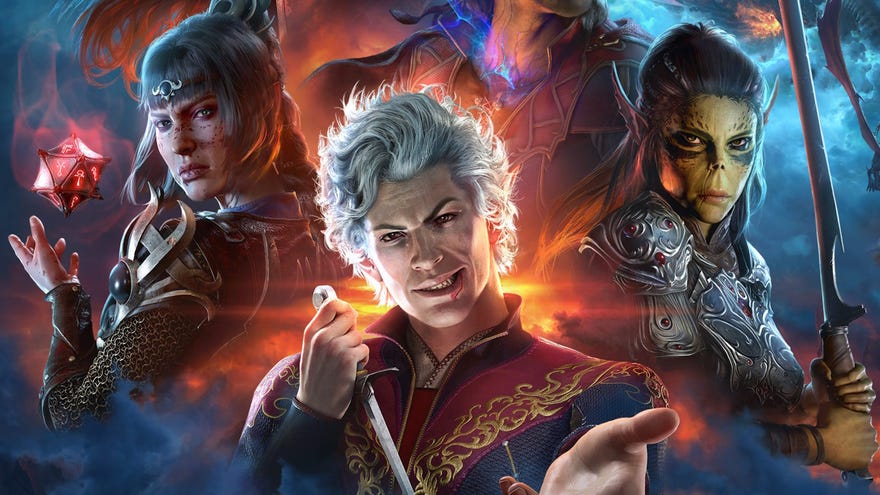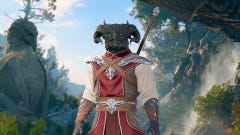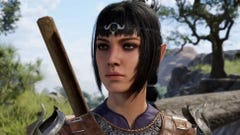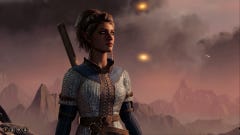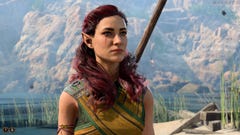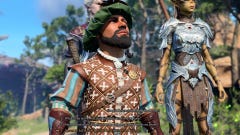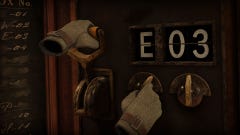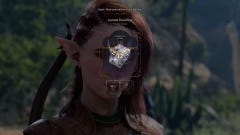How Baldur's Gate 3 morphed Larian Studios into wild new shapes
"If that’s what it takes, that’s what it takes"
The distance from the roof of the Counting House to the nearest building in Baldur’s Gate is vast, by design. The waterfront bank where the city’s great, good and gangster store their gold stands with its back to the sea, while a long and well-guarded bridge extends from its maw, like a money-hungry tongue. Legend says its top two floors are entirely without windows, the House an eyeless god to the citizens who reside on the hillside that slopes down toward the docks. So how was Gale, the wizard prodigy, able to bound from a faraway balcony to the brim of the bank, as if stepping lazily out onto his porch with a mug of coffee? Some say strange sorcery was afoot, but I’ve seen his character sheet, and so can be more specific.
Upon levelling up, Gale multiclassed as a sorcerer - an odd choice, but one that allowed him to unlock the ability to throw magic from a great range. Suddenly, while casting a teleport spell, this hybrid mage was able to reach across the wide moat of the Counting House and land safely on a high ledge. It’s one of many obscure class synergies via which, Larian imagines, you’ll be able to break their level design in unexpected and entertaining ways.
Not that Gale’s new vantage point offered any obvious entry points - only austere, imposing brickwork. That and a narrow pipe, through which smoke might leave the building. Popping open a flask, Gale gulped down a potion and instantly assumed gaseous form - drifting through the pipe into the House as a misty cloud. Once inside, he had only to dodge the traps, the guards, and the regularly-placed alarm posts which promised to trumpet his presence to anyone within hearing distance. Then to break into the vaults themselves - the keys to many of which can be pilfered from the pockets of individuals dotted throughout the Sword Coast’s metropolis.
It’s a deliciously deep and complicated heist scenario that would slot perfectly into a Dishonored game - rich with vertiginous architecture and open-ended opportunities to solve your navigational problems. And yet it’s just one tiny corner of Baldur's Gate 3, a three-act campaign which, besides being an isometric immersive sim, is also an enormous story-driven RPG stuffed with branching Bioware-style cinematics that account for countless variations in your character build, companion selection and dialogue choices.
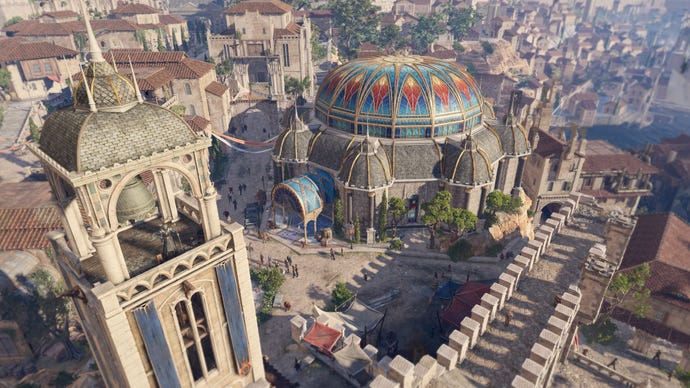
The titular city, which takes up almost the entirety of the campaign’s final act, defies comparison and belief. On the surface it doesn’t look so different to Novigrad, say - but that which is set dressing in The Witcher is three-dimensional here. The busy crowds buzz with overlapping conversation as you walk by, hinting at dark deals and quest threads waiting to be pulled. A mysterious explosion rocks the ground floor of a building as you pass. And, should you leave the street, you’ll find dozens and dozens of individual homes dressed with the density and care you’d expect from Larian’s prior work in the Divinity series. The enormous scale of Baldur’s Gate has come with very little apparent compromise - though that wasn’t the original idea.
“The plan for the city was going to be smaller hubs connected by portals,” says Larian CEO and creative director Swen Vincke. “It would look like you were in a big city. But you would go to a location, and be teleported to the other side of it. And so we didn't have to make it that dense.”
But the prototype Larian made - which Vincke expects will be shown to the public as a historical curio in the fullness of time - simply didn’t work very well. “It was certainly easier to make, but it wasn’t that good,” he says. “The thing that it failed to do was capture what you had in the first act, which was that freedom of being able to go anywhere. It didn’t have that. And so it was like, ‘It’s not the same game, guys. What are we going to do?’ Well, there’s only one right way of doing it.” Some vistas remain that can’t be reached, “but the city is now very large, so it feels like you’re really in it.”
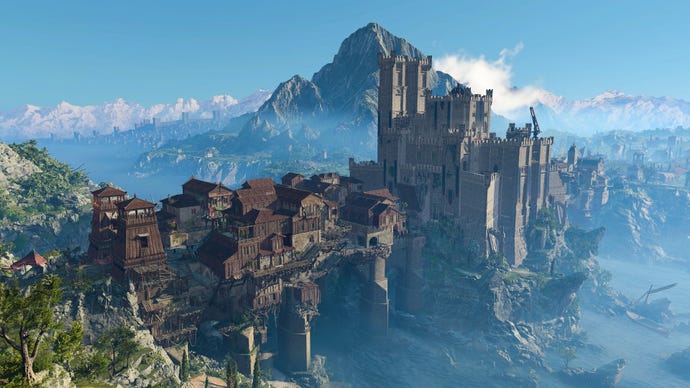
The maximalist conclusion that Larian reached is one of the reasons that the developer has swelled, from 120 people at the start of the project to almost 450 today. Besides the HQ in Ghent, there are also now Larian studios in Kuala Lumpur, Barcelona, Guildford, Dublin and Quebec. For a little while there was one in Russia, too, before the war in Ukraine forced it to close. “The growth was necessary to be able to make this type of game, and that was the ambition,” Vincke says. “We want to be able to tell you a cinematic story that’s fully driven by your choices. And if that’s what it takes, that’s what it takes.”
“We want to be able to tell you a cinematic story that’s fully driven by your choices. And if that’s what it takes, that’s what it takes.”
Beyond that standing army, there are the many less visible partner studios that Larian work with outside their own ecosystem. To pick one example, there’s Fool’s Theory - the Polish developer of The Thaumaturge and the upcoming Witcher Remake, whose underplayed 2017 RPG, Seven, has similar immersive sim leanings to Baldur’s Gate 3. They’ve provided Larian with gameplay and tools programming support. If you were to add all of the partner studios to the total number of staff working on Baldur’s Gate 3, well... Vincke doesn’t even know what the figure would come to. “I just know it’s large.”
On one level, that’s extraordinarily exciting. The bravest indie RPG company in the world found such success with the Divinity: Original Sin games that they're now, against the odds, the wild card of AAA. Think CD Projekt Red on the cusp of Wild Hunt - a European outlier at the peak of their abilities, building on the triumphs of two prior releases, ready to reshape the genre for a mass audience.
On another level, however, it’s alarming. Developers that rapidly expand to meet a project’s needs often go through cultural convulsions - losing part of their identity in the process.
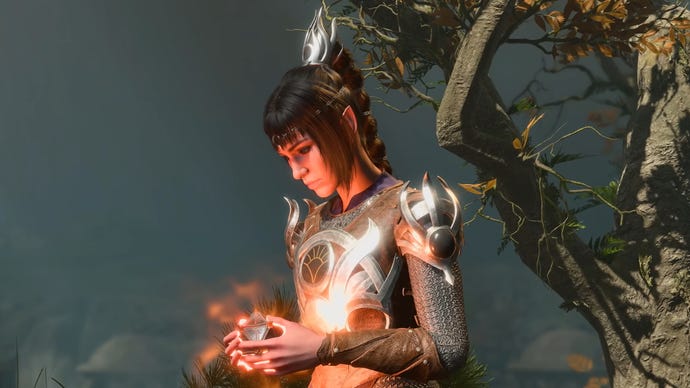
Larian, to their credit, have attempted to protect against much of that - building new studios around trusted partners they've worked with for a long time. The team in Barcelona, for example, had previously worked on the Switch version of Divinity: Original Sin 2, and so were a shoo-in to help with Baldur’s Gate 3’s staggered multi-platform launch. “We noticed that if there’s ownership inside the studio of the content, you get much more creative drive than if it’s a work-for-hire relationship,” Vincke says.
Even so, hiring extra staff has been tricky. Larian subscribe to a highly particular and permissive design philosophy that impacts all sorts of development disciplines - so having worked on an acclaimed hit game doesn’t necessarily mean you’re a good fit for Baldur’s Gate 3.
“It’s horrible, to be honest,” Vincke says. “We used to work on pedigree, and we don’t do that anymore. You gotta take a test. You get these people with enormous CVs, and you think, ‘I know you can write, I’ve seen your writing, I love your writing. But I don’t know if you can write for us.’ We do things differently because of our systems approach. And so either you love it, and then you’re fully engaged. But you’ll equally find writers that said, ‘I hated it.’ That’s OK. We like a very specific thing that’s not the norm.”
Much of Larian’s growth has been driven by their new cinematic bent. “We underestimated that,” Vincke admits. “We also didn’t expect that we would need the 174 hours of cinematic content that’s been recorded and mo-capped. But it was necessary for the reactivity. If I just lost the person that was most dear to me, and there’s a scene happening afterwards, it needs to react to that. Otherwise I don’t buy it anymore.”
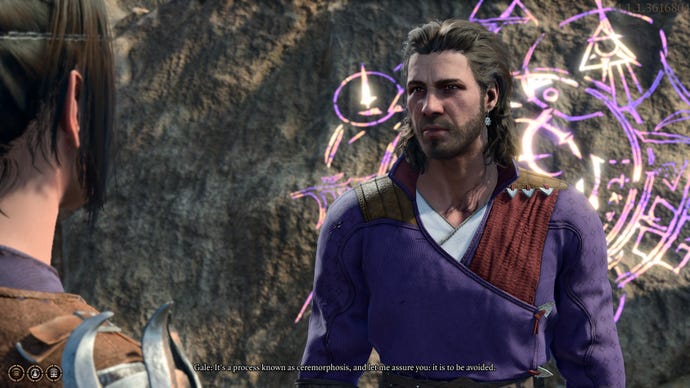
A big chunk of Larian’s cinematics team - which has enabled the Bioware-esque close camerawork of Baldur’s Gate 3 - came from Telltale. Few developers have as much prior experience with dynamic cutscenes impacted by player choice. But even they initially struggled with the ludicrous number of possible permutations the game accounts for. “It was a beautiful marriage of two worlds that normally don’t meet each other,” Vincke says. “And as with any marriage it was tumultuous.”
A scene in Baldur’s Gate 3’s early access build acted as a litmus test, and turned into a “big argument between systems, combat and cinematics”. It kicked off with a shouting goblin on a roof - a classic Python-style comedy setup. But as the systems and combat teams pointed out, a player might have pushed said goblin onto the ground before the cinematic even started. “That got so much discussion,” Vincke says. “Where the fuck do I put my camera? Everywhere?”
By now, as evidenced by the Baldur’s Gate 3 seen in streams and trailers, the various disciplines of the expanded Larian Studios are simpatico. The next question is, with the game launching today on August 3rd, what happens afterwards.
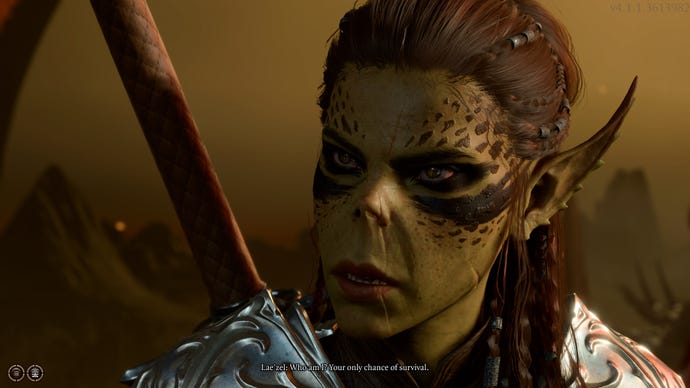
"If it flops? Well, that's gonna be a different conversation than if it does OK, which is gonna be different than if it does good or very, very good."
“There’s degrees of how well the game has to do,” Vincke says. “If it flops? Well, that's gonna be a different conversation than if it does OK, which is gonna be different than if it does good or very, very good. Certainly we can manage the future. But we do need some sales. If we don’t have any, it'll be like what you would expect for any studio. So we’ll see. We’re dependent on the market, like any company is.”
Larian have plenty of plans for their next projects, however. “We have a number of things that we’re working on, that are in early pre-production or concept phase,” Vincke says. “We’ll see where it goes.” There will be support for Baldur’s Gate 3, but there’s also an eagerness internally, after more than half a decade in production through Covid and the war in Ukraine, to work on something else. “It’s gonna be time to do new things,” Vincke says.
“I think the next year will be a pretty cool period because it will be a lot of experimentation,” he adds. “There’s a lot of stuff that we want to try out that we haven’t had the time to. There will be new techniques and procedures and technology. Probably the biggest challenge from my point of view will be to keep the plans manageable, rather than the opposite.”
Disclosure: Former RPS deputy editor Adam Smith (RPS in peace) now works at Larian and is the lead writer for Baldur's Gate 3. Former contributor Emily Gera also works on it.
